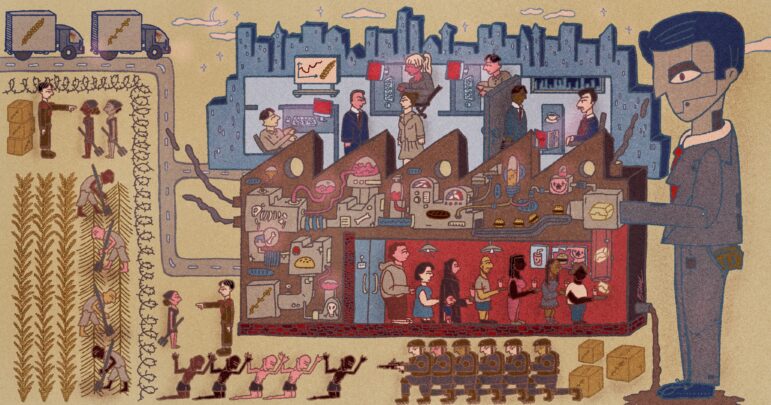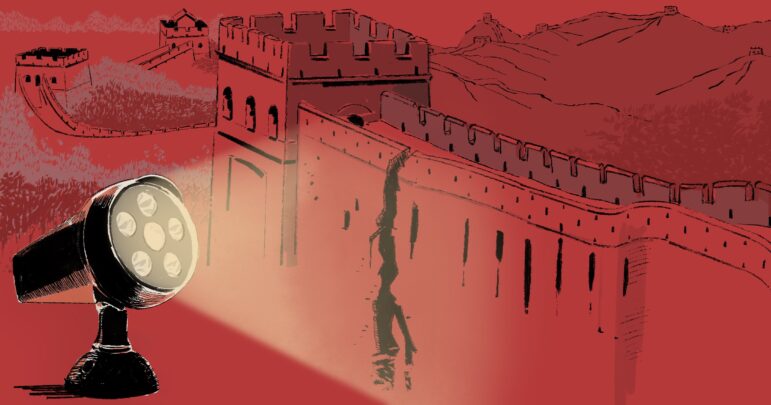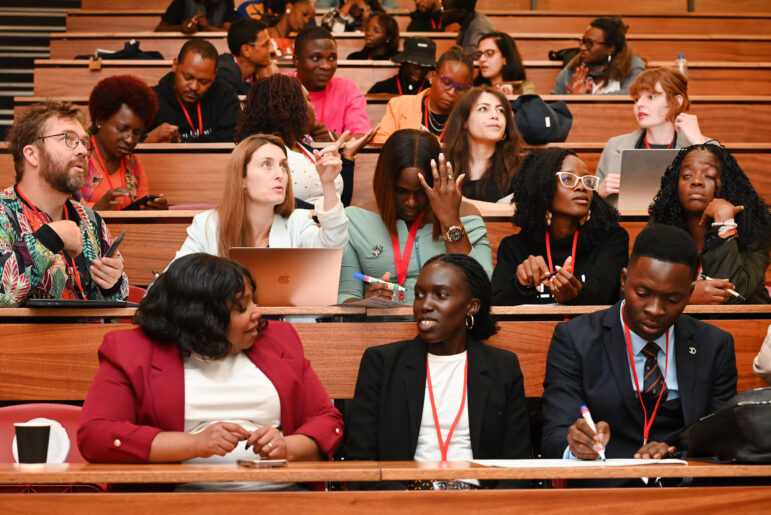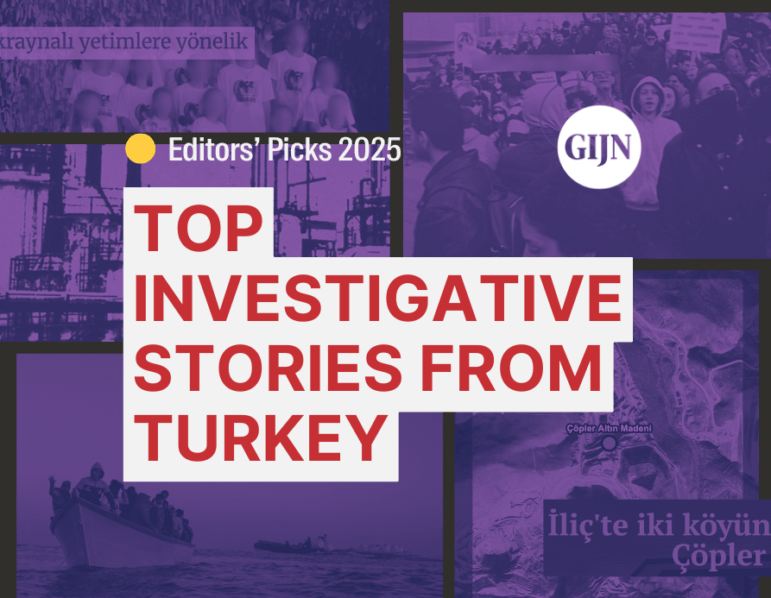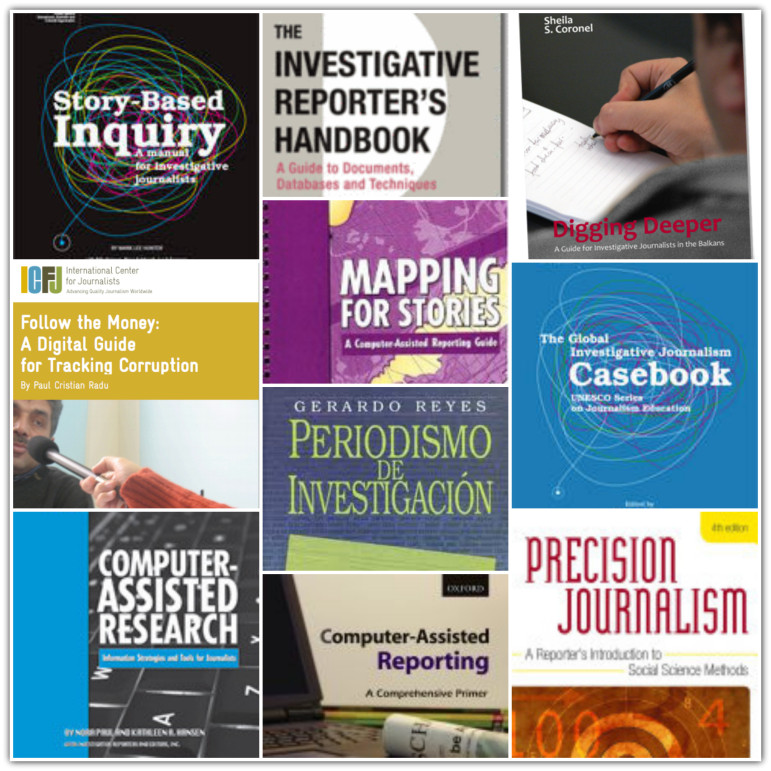

Investigative Journalism Manuals
Looking for tips, tools, and tutorials? The below guides focus on investigative journalism and provide case studies and examples from around the world. Most are available for free, unless indicated otherwise.
You can also find our guide to investigative journalism manuals in Chinese and Spanish. Have an addition that you’d like to share? Send us an email and let us know.
Investigative Journalism
Hybrid Investigative Journalism: This book explores entrepreneurial attempts to combine traditional investigative journalism with alternative ways of organising this work. It transcends watershed investigative projects in favour of the ways in which new actors (citizens, technologists, bloggers and local reporters, among others) join experienced in vestigative journalists in experiments with the practices of watchdog journalism in the digital era. Cases include Bristol Cable, Bureau Local and the Korea Center for Investigative Journalism, as well as Forbidden Stories. The book also includes two chapters on the impact of COVID-19 upon the development of cross-disciplinary work in a traditional newsroom and in the larger media ecosystems of both Norway and China. This is a timely book for journalism students, scholars and investigative reporters, who share a passion for this form of journalism. Published in 2024. Language: English.
vestigative journalists in experiments with the practices of watchdog journalism in the digital era. Cases include Bristol Cable, Bureau Local and the Korea Center for Investigative Journalism, as well as Forbidden Stories. The book also includes two chapters on the impact of COVID-19 upon the development of cross-disciplinary work in a traditional newsroom and in the larger media ecosystems of both Norway and China. This is a timely book for journalism students, scholars and investigative reporters, who share a passion for this form of journalism. Published in 2024. Language: English.
Investigate – The Manual: This manual was designed in order to provide readers with an overview of state of the art practices in investigative journalism, with a focus on illicit financial flows and asset recovery. It has an introductory to intermediate level. It is the result of over three years of collaboration between CiFAR and civil society organizations specialized in various fields of expertise relevant to the practice of journalism. Three supporting case studies have been added as an illustration of the use of these tools and techniques, based on investigative cross-border stories published by some of CiFAR’s trainees. Languages: English; French | Français.
Modern Investigative Journalism: By Mark Lee Hunter and Luuk Sengers, with Marcus Lindemann, this is described as a curriculum that “goes beyond what to teach: it helps beginning instructors in the field to see how to teach it, by describing typical questions that students will ask (along with the answers), along with classroom exercises and take-home assignments that instruct through creative discussion and experience.” By the authors of Story-Based Inquiry (see below). Also, see slides from their GIJC19 presentation. Language: English.
 Investigative Journalism Manual: This useful guide began as a handbook for African journalists, with case studies and exercises, published by the German foundation Konrad Adenauer Stiftung. The latest edition is global and is designed for reporters facing as repressive media laws, lack of transparency, and limited resources. Languages: English; Bangla | বাংলা; Burmese | ဗမာ; Mandarin | 中文; Dzongkha | རྫོང་ཁ; Greek | Ελληνικά; Bahasa Indonesia; Japanese | 日本語; Korean | 한국어; Mongolian | Монгол; Nepali | नेपाली; Sinhala | සිංහල; Spanish | Español; Tamil | தமிழ்; Vietnamese | Tiếng Việt.
Investigative Journalism Manual: This useful guide began as a handbook for African journalists, with case studies and exercises, published by the German foundation Konrad Adenauer Stiftung. The latest edition is global and is designed for reporters facing as repressive media laws, lack of transparency, and limited resources. Languages: English; Bangla | বাংলা; Burmese | ဗမာ; Mandarin | 中文; Dzongkha | རྫོང་ཁ; Greek | Ελληνικά; Bahasa Indonesia; Japanese | 日本語; Korean | 한국어; Mongolian | Монгол; Nepali | नेपाली; Sinhala | සිංහල; Spanish | Español; Tamil | தமிழ்; Vietnamese | Tiếng Việt.
Digging Deeper: A Guide for Investigative Journalists in the Balkans: This guide, published by the Balkan Investigative Reporting Network (BIRN), focuses on how to dig up records and data in the region. Author Sheila Coronel, director of Columbia University’s Stabile Center for Investigative Journalism, also offers tips and techniques on investigative reporting. Download the first chapter for free. Languages: English; Macedonian | македонски.
Investigative Journalism Handbook: From the Al Jazeera Media Institute, this manual is primarily aimed at Arab journalists. It hopes to equip journalists with the skills to do research, to think critically, to fact-check and to make good use of their common sense. By doing so, they hope to contribute – even if only a little – to the process of “seizing reality back” from the powerful. Languages: English; Arabic | العربية.
Drehbuch der Recherche (Script for Investigations): By Mark Lee Hunter and Luuk Sengers, and published by Netzwerk Recherche, the authors explain how to plan, carry out and deliver investigative research – from the idea to the story. Language: German | Deutsch.
Exposing the Truth: A Guide to Investigative Reporting in Albania: This 73-page manual gives journalists the principles and skills – from tracking people using geo-location data on Instagram to unpicking a press release – to make their reporting more efficient and incisive. Published by OSCE and the Balkan Investigative Reporting Network. Languages: English; Albanian | Shqip.
The Hidden Scenario: This 2019 book by Luuk Sengers and Mark Lee Hunter “focuses on how making a scenario can help you investigate.” Available for purchase from the Center for Investigative Journalism. Language: English.
Global Investigative Journalism Casebook: This casebook accompanies Story-Based Inquiry (see below). It serves as a complementary material for training purposes, and aims to enable and enhance the exchange of good practices and networking in investigative journalism throughout the world. The casebook contains more than 20 investigative stories from nearly every corner of the globe, covering a wide variety of topical subjects of special interest to UNESCO, such as freedom of information, good governance, social and legal issues, the environment, health, and gender. Languages: English.
Global Investigative Journalism: Strategies for Support: A survey and discussion of the global spread of investigative journalism by GIJN’s former executive director David E. Kaplan, with tips on the structure of investigative nonprofits and funding sources, plus a guide to groups worldwide. Published by the Center for International Media Assistance. Languages: English.
Citizen Investigation Guide: This 2019 guide from GIJN is designed to help citizens do investigative reporting. Citizen investigators include ordinary citizens, members of nongovernmental organizations, and non-journalism professionals interested in using investigative techniques to uncover wrongdoing and expose the invisible. Languages: English, Bangla | বাংলা; French | Français; Spanish | Español.
Guide to Investigative Journalism: This simple 2007 series by the Public Broadcasting Service in the U.S. takes the reporter through how to identify a story, conduct an investigative interview, locate and obtain documents, package your story, and get it out to the public. Language: English.
Investigating Religion: An Investigative Reporter’s Guide: This manual from IRE offers reporters a guide to the many different religious organizations. It includes a roundup of some of the world’s more well-known religions, 990s and other tax forms that are available for request, and tips on finding sources in the religious community and knowing which are credible. Language: English.
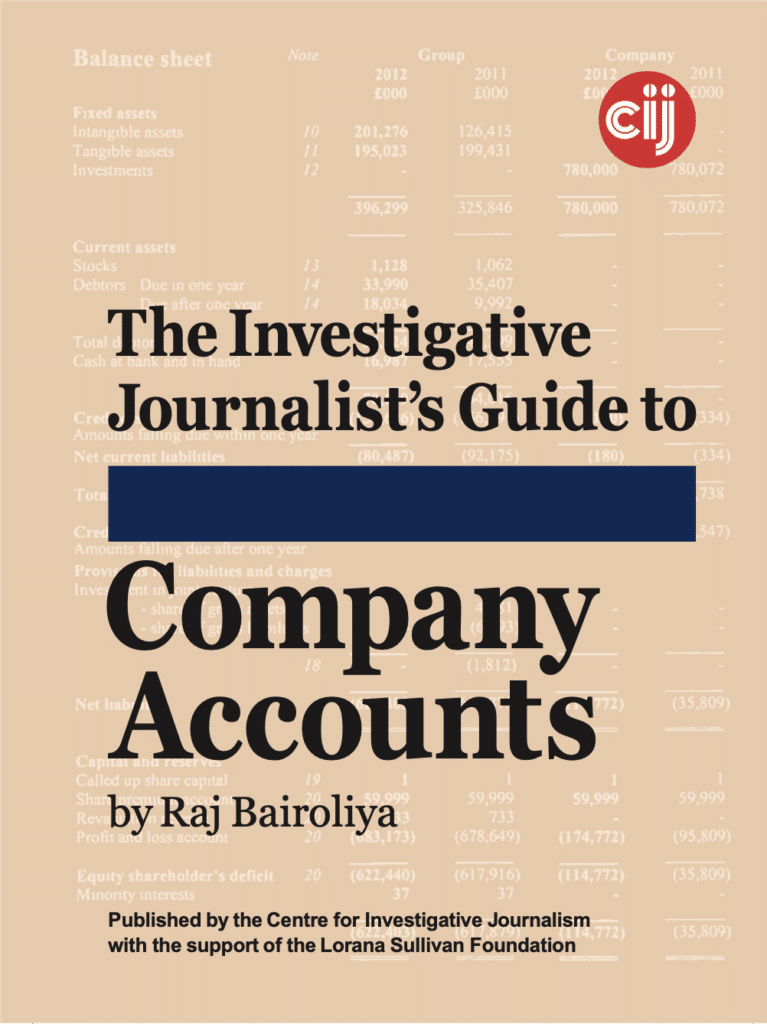
Investigative Journalist’s Guide to Company Accounts: This guide by forensic accountant Raj Bairoliya, published by the Centre for Investigative Journalism, is for investigative journalists who need to make sense of a set of company accounts (mostly trading companies) or to obtain an overview of a business in order to ask “on-the-money” questions. Language: English.
Investigative Online Search: This guide, published by the Centre for Investigative Journalism in 2011, discusses how to find information online and verify its veracity. Languages: English.
Investigative Photography: Supporting a Story with Pictures: This manual has been written for journalists, NGO workers and other individuals for whom photography could be useful to support their work. It is not a guide to taking better pictures, but how to use the camera for evidence gathering. It gives an overview of how photography can be used as part of an investigation or to support a story. Language: English.
Investigative Reporter’s Handbook (5th Edition): By Brant Houston and Investigative Reporters and Editors, this handbook is useful in advanced journalism courses and as a reference for professional journalists, and shows students how to use fundamental news reporting and writing skills like gathering sources, tracking information, and interviewing, to pursue investigative stories in a variety of beats — from the government and education to healthcare, the environment and real estate. Language: English.
Investigative Reporting: A Toolkit for Reporters: This 107-page guide published in 2009 by the US Center for International Private Enterprise is designed as a living document to guide Egyptian reporters in developing, writing and producing investigative reporting stories and series. Language: English.
Investigative Reporting in Emerging Democracies: Models, Challenges, and Lessons Learned: A report by Drew Sullivan of the Organized Crime and Corruption Reporting Project shares tips on designing programs, upholding standards, the need for editors, safety, and more. Published by the Center for International Media Assistance. Language: English.
Manual for Arab Journalists on Freedom of Information and Investigative Reporting: A free, downloadable, 21-page handbook by Article 19, funded by the United Nations Development Programme, provides guidelines of FOI and investigative journalism to equip journalists with basic skills for writing investigative reports and campaigning for their right to access information. Language: English.
The News Initiative: From Google, this initiative provides a nine-segment course in investigative journalism, geared toward the use of Google tools. Language: English.
The Science Writers’ Investigative Reporting Handbook: Both science writers and investigative reporters rely on analytical skills, curiosity, skepticism and a knack for sussing out dubious claims, Liza Gross notes in this handbook. Written with support from a NASW Peggy Girshman Idea Grant, this manual explains how to explore the story behind the story, detect biases, and find concealed information. Language: English.
Raising Hell: A Citizen’s Guide to the Fine Art of Investigation: The Center for Investigative Reporting, the world’s first nonprofit investigative reporting center, offers this guide to train the general public on how to “investigate, uncover corruption and expose the weak spots of power.” Language: English.
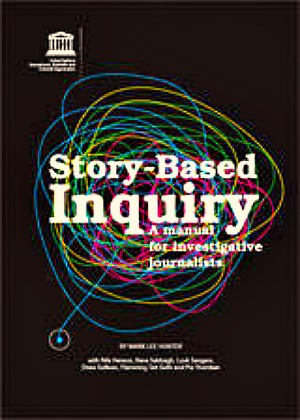 Reporting in Indigenous Communities was written by Canadian Broadcasting Corporation reporter Duncan McCue in 2011. It has applications for coverage of indigenous peoples internationally. See the Reporter’s Checklist, blog, and a 2018 interview with McCue. Language: English.
Reporting in Indigenous Communities was written by Canadian Broadcasting Corporation reporter Duncan McCue in 2011. It has applications for coverage of indigenous peoples internationally. See the Reporter’s Checklist, blog, and a 2018 interview with McCue. Language: English.
Story-Based Inquiry: A comprehensive guide to investigative reporting, co-authored by Mark Hunter, Drew Sullivan, Pia Thosden, Rana Sabbagh, and Luuk Sengers. This UNESCO-funded manual uses case studies to illustrate methods and skills, including research, writing, quality control, and dissemination. Languages: English; Arabic | العربية; Chinese | 中文; French | Français; Russian | русский; Portuguese | Português; Spanish | Español.
The Story Tells the Facts: This manual addresses storytelling techniques for writers and filmmakers, showing how a research database can be transformed into a narrative structure. Language: English.
Undercover Reporting: Not a manual but an online database and resource center, this website grew out of research for the book Undercover Reporting: The Truth About Deception. The site includes scores of examples going back more than 100 years. Language: English.
The Verification Handbook: With 10 chapters and three case studies, this book sheds light on the use of open data and open source information to produce critical journalistic investigations. As new challenges have emerged in the digital sphere, wider opportunities to carry out more comprehensive investigations have arisen as well. The authors of the book take the reader on a walk-through to hone their online investigation tactics, providing them with step-by-step guidance to apply research, fact-checking, and data journalism techniques. Languages: English; Greek | Ελληνικά; French | Français; Portuguese | Português; Spanish | Español; Arabic | العربية; Ukrainian | українській; Turkish | Türkçe; Croatian | Hrvatski.
A Watchdog’s Guide to Investigative Reporting: Emphasizing reporting in Africa, this guide provides examples of good practice and looks at the challenges of investigative reporting for those curious about pursuing such assignments. Language: English.
Data Journalism
Lessons from 30 Years Of Teaching Journalists Data Journalism, a GIJC19 tipsheet by Brant Houston, the Knight Chair in Investigative Reporting at the University of Illinois. For more than a decade, he was executive director of Investigative Reporters and Editors.
Teach Computational Thinking, Not Just Spreadsheets or Coding, a GIJC19 tipsheet from Paul Bradshaw, Birmingham City University/BBC Data Unit
7 countries, 9 teachers: a dossier of data journalism teaching strategies What are the most effective ways to introduce students to data? By Nouha Belaid, Anastasia Valeeva, Bahareh Heravi, Roselyn Du, Kayt Davies, Adrian Pino, Eduard Martín Borregon, Soledad Arreguez, and Jeff Kelly Lowenstein.
Data and Computational Journalism, this 2020 article “offers four recommendations to help educators adjust curricula to accommodate the rapid integration of data into journalism.” the authors are Norman P. Lewis, Mindy McAdams, and Florian Stalph. Their four points:
First, instruction in numeracy and basic descriptive statistics must be required as either module in existing courses or as separate offerings. Second, students should be taught to avoid mistakes in interpreting and writing about data in both reporting and visual classes. Third, ethics courses should discuss data as a transparency tool that poses distinctive dilemmas. Fourth, computational thinking, or how to dissect and solve problems like a computer does, can be incorporated into existing classes that teach logic.
More Effective Teaching of Data Journalism to Working Journalists, by Kuang Keng Kuek Ser of Data-N, presented at GIJC19. The tips are intended for trainers/educators who teach data journalism to working journalists new to the field.
Hacking the curriculum: How to teach data reporting in journalism schools An American Press Institute Report from 2018. “Our central recommendation is for journalism schools to treat data and computation as core skills for all students.”
Where in the world can I study data journalism? This 2019 article by Bahareh Heravi summarizes her academic paper on this topic, entitles 3Ws of Data Journalism Education, published by Data Journalism Practice. An open-access post-print of the paper could be accessed via UCD academic repository. Includes a map.
International Journalism Education Consortium: Links and descriptions to syllabi from computer-assisted and data journalism courses (In alphabetical order of university, then professor’s name).
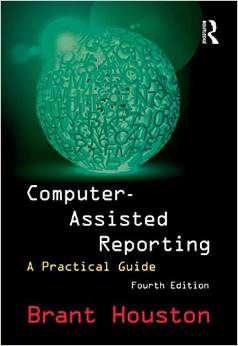 Computer-Assisted Reporting: A Comprehensive Primer: By Fred Vallance-Jones and David McKie [available for purchase]. Languages: English
Computer-Assisted Reporting: A Comprehensive Primer: By Fred Vallance-Jones and David McKie [available for purchase]. Languages: English
Computer-Assisted Reporting: A Practical Guide: the 4th edition by Brant Houston [available for purchase]. Languages: English
Computer-Assisted Research: Information Strategies and Tools for Journalists: By Nora Paul and Kathleen A. Hansen [available for purchase from IRE]. Languages: English
Data Journalism Handbook is an international, collaborative effort involving dozens of data journalism experts. Includes definitions, case studies, and tips on how to get, use, and analyze data. An initiative of the European Journalism Centre and the Open Knowledge Foundation. Languages: Available for download in Arabic, English, French, Russian, and Spanish. The handbook is also being translated into several other languages, including Georgian. The 2012 edition was translated into over 12 languages — including Arabic, Chinese, Czech, French, Georgian, Greek, Italian, Macedonian, Portuguese, Russian, Spanish, and Ukrainian
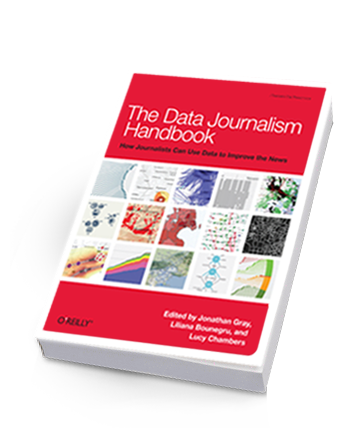 Flowing Data is run by statistician Nathan Yau, author of Data Points: Visualization that Means Something and Visualize This: The FlowingData Guide to Design, Visualization, and Statistics. The Learning to Data section has links to tutorials, books, and guides related to working with data.
Flowing Data is run by statistician Nathan Yau, author of Data Points: Visualization that Means Something and Visualize This: The FlowingData Guide to Design, Visualization, and Statistics. The Learning to Data section has links to tutorials, books, and guides related to working with data.
Mapping for Stories: A Computer-Assisted Reporting Guide, By Jennifer LaFleur and Andy Lehren [available for purchase from IRE]. Languages: English
Precision Journalism: a Reporter’s Introduction to Social Science Methods, by Philip Meyer [available for purchase]. Languages: English
Datawrapper materials for workshops.
For more information on general data journalism resources, see our Data Journalism Resource Page.
Teaching and Training
Model Curricula for Journalism Education: A guide targeted at journalism faculty in developing countries and emerging democracies. Developed by UNESCO, the manual offers syllabi for 17 courses – including investigative reporting – that can be tailored to the needs of each country. Languages: English (PDF); French | Français (PDF); Spanish | Español (PDF); Russian | Pусский (PDF); Arabic | العربية (PDF); Chinese | 中文 (PDF); Nepali (PDF); Portuguese | Português (PDF); Farsi | فارسی (PDF).
UNESCO’s Teaching Journalism Online: A Handbook for Journalism Educators: Provides comprehensive guidance for adapting journalism education to online formats. It covers a range of topics including digital pedagogy, interactive tools, and best practices for online instruction. The handbook emphasizes the importance of maintaining quality and engagement in digital environments, offering practical tips for educators to effectively teach journalism remotely. It serves as a valuable resource for educators looking to enhance their teaching methods in the digital age. Languages: Russian | Pусский; Arabic | العربية.
IREX’s Digital Journalism Trainers Manual: A comprehensive guide designed to support trainers in educating aspiring journalists in digital skills. The manual covers essential topics such as digital ethics, multimedia storytelling, social media strategies, and investigative journalism in the digital age. It provides practical exercises, case studies, and detailed lesson plans to enhance training effectiveness. Aimed at equipping trainers with the tools needed to develop skilled digital journalists, this manual is a valuable resource for adapting to the evolving media landscape. Languages: Arabic | العربية.
International Journalism Education Consortium: Investigative journalism course descriptions and syllabi from investigative journalism courses. (In alphabetical order of university, then professor’s name).
Algorithms for Journalists: A course syllabus of the algorithms class taught by computational journalist Jonathan Stray at Columbia Journalism School’s The Lede program. It’s up on GitHub, with links to slides, reading material, and exercises. Note that the class is intended for students with a beginner’s level in Python programming.
Better News: A website with a number of resources, run by the American Press Institute.
AEJMC Task Force for Bridges to the Professions 2017 Report A 2017 report on cooperation between academia and journalists from the Association for Education in Journalism and Mass Communication (AEJMC).
Observations on how we teach drone journalism, by Judd Slivka, Missouri School of Journalism’s first director of aerial journalism.
Algorithms course materials at Columbia Journalism School Teaching algorithms curriculum by Columbia professor Jonathan Stray.
The Field Guide to Security Training is a curriculum hosted by OpenNews, a team that helps developers, designers, and data analysts convene and collaborate on open journalism projects, and BuzzFeed Open Lab, an arts and technology fellowship program at BuzzFeed News.
Other Useful Guides
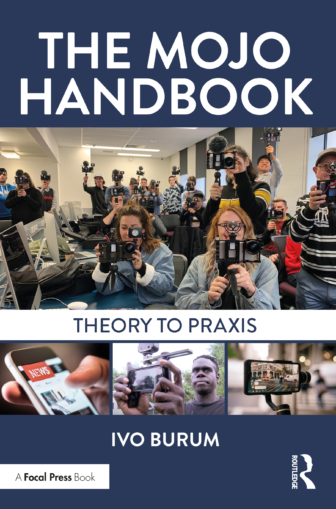 “The Mojo Handbook: Theory to Praxis,” by Ivo Burum. This 350-page guide is written by GIJN’s own Mojo Workin’ columnist Ivo Burum, and offers a crash course in using mobile tools to tell multifaceted stories. With tips on recording documentary-style video footage and clean audio, editing on your phone, and mobile storytelling for creating engaging and compelling content, it covers all the bases.
“The Mojo Handbook: Theory to Praxis,” by Ivo Burum. This 350-page guide is written by GIJN’s own Mojo Workin’ columnist Ivo Burum, and offers a crash course in using mobile tools to tell multifaceted stories. With tips on recording documentary-style video footage and clean audio, editing on your phone, and mobile storytelling for creating engaging and compelling content, it covers all the bases.
The James W. Foley Journalism Safety Modules were developed to introduce journalism and communications students to safety as a key component of the craft of journalism. The modules were created by the James W. Foley Legacy Foundation in collaboration with the Marquette University Diederich College of Communication. The 16 safety modules cover a variety of topics, including, but not limited to, completing risk assessments, the responsibilities of newsroom managers, the safety of female and minority journalists, covering civil unrest (including protests), reporting during the current pandemic, emotional self-care, care of sources, interviewing hostile sources, reporting on foreign conflicts, protecting digital data, and covering weather-related stories. Along the way, students will learn to view safety as an essential component of strong, healthy, and ethical journalism. The James W. Foley Foundation offers a number of safety curricula.
“A Taste for Trouble,” by Aniruddha Bahal. Twenty years ago, Bahal created a global storm by investigating match-fixing by some of India’s top cricketers. You don’t take on the establishment running India’s top sport lightly, and Bahal earned a name for himself as “the father of sting journalism in India.” His latest book, “A Taste for Trouble,” was penned during lockdown, and explores everything from his childhood to setting up his own investigative outlet (GIJN member Cobrapost) at a time when — according to the Hindustan Times — “speaking truth to power was no longer on the agenda of media houses.”
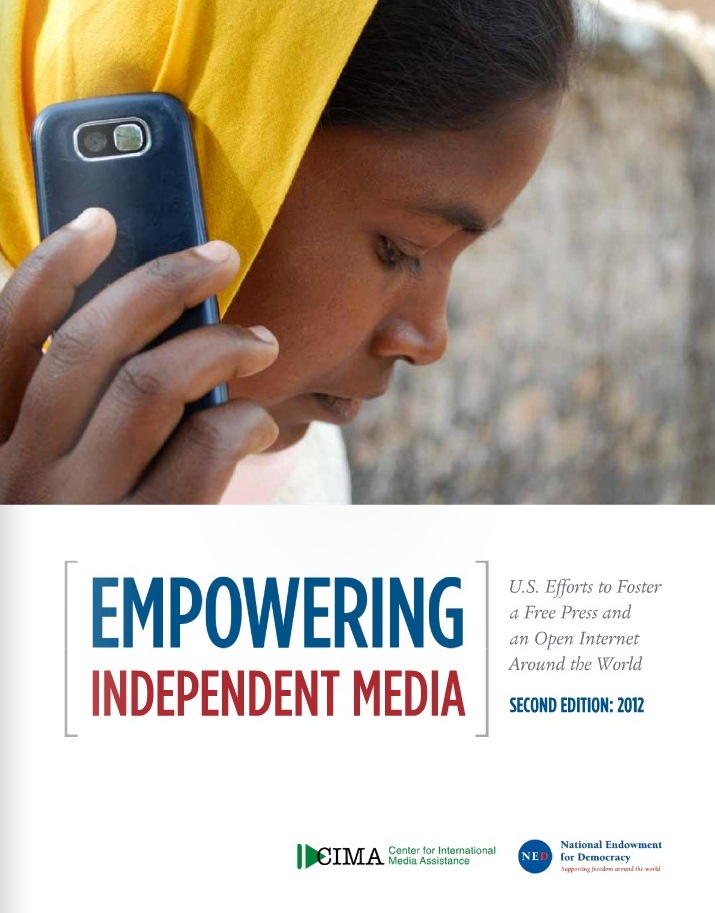
Empowering Independent Media: U.S. Efforts to Foster a Free Press and an Open Internet Around the World: A comprehensive look at media development, useful for media nonprofits and NGOs in developing and transitioning countries. Covers seven core areas of media development: funding, digital media, sustainability, media law, safety, education, and monitoring and evaluation. Languages: English, Spanish, French.
Google Search Tips for Journalists: This short, handy guide gives valuable tips for more effective research using Google’s search engine. Compiled by Expertisefinder.com.
Journalist Survival Guide: Produced by the Beirut-based Samir Kassir Foundation, this animated guide is designed to primarily aid journalists and activists working in war zones and conflict areas, but also includes tips on digital security and covering your tracks. Languages: English, Arabic
Legal Leaks Toolkit: A Guide for Journalists on How To Access Government Information: A useful 75-page booklet covers basics for journalists going through formal channels to obtain official documents. Prepared by Access Info Europe and the Network for Reporting on Eastern Europe n-ost. Available in English, Italian, Russian, Italian, Macedonian, Bosnian, Croatian, Hungarian, and Serbian.
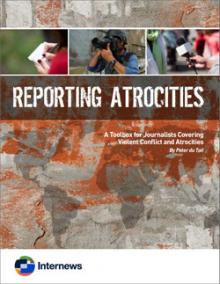 Reporting Atrocities: A Toolbox for Journalists Covering Violent Conflict and Atrocities: This detailed, 61-page guide looks at the nature of conflict, how to cover it, and the role of the journalist in such situations. Written by South African journalist Peter du Toit and published by Internews. Languages: English
Reporting Atrocities: A Toolbox for Journalists Covering Violent Conflict and Atrocities: This detailed, 61-page guide looks at the nature of conflict, how to cover it, and the role of the journalist in such situations. Written by South African journalist Peter du Toit and published by Internews. Languages: English
Reporting on Corruption: A Resource Tool for Governments and Journalists: This 117-page guidebook by the UN Office on Drugs and Crime gets mired in bureaucratic discussion and UN-speak, but there are useful case studies and resources. Includes protection of sources, right to information, and self-regulatory measures.
SEEMO Safety Net Manual: Guidelines for Journalists in Extraordinary or Emergency Situations: This safety manual–published by the South East Europe Media Organization–is part of a wider initiative to protect media workers in the region. Languages: English and, Serbian, Italian, Romanian, Greek, Turkish, Bulgarian, Croatian, and Slovenian.
Tragedies & Journalists: A 40-page guide with practical tips to help journalists, photojournalists, and editors report on violence while protecting both victims and themselves. Published by the Dart Center for Journalism & Trauma, and written by Joe Hight and Frank Smyth. Languages: English, Spanish, 中文 (Chinese).
Verification Handbook is a resource for journalists and aid providers from the European Journalism Centre. It provides the tools, techniques, and step-by-step guidelines for how to deal with user-generated content (UGC) during emergencies. Languages: English, Português, العربية , Español.
Who’s Running the Company: A Guide to Reporting on Corporate Governance: An introduction to reporting on corporate governance, with sections on boards of directors, financial reports, and tracking company performance. Produced by the World Bank’s International Finance Corporation with the International Center for Journalists. Languages: English (PDF); French | Français (PDF); Spanish | Español (PDF); Bahasa Indonesia (PDF); Mongolian | МОНГОЛ ХЭЛ (PDF); Arabic | العربية (PDF); Russian | Pусский (PDF); and Portuguese | Português (PDF).
Security and Covering Conflict: IJNet has compiled a list of guides to journalist security and covering conflict from various organizations. Some are available in multiple languages such as Arabic, Chinese, Russian, and Spanish.
For investigative journalism syllabi visit this page.
Spanish Only
The following guides are available only in Spanish. See also the reports listed above — several are published in Spanish — and also this full resource page en Español.
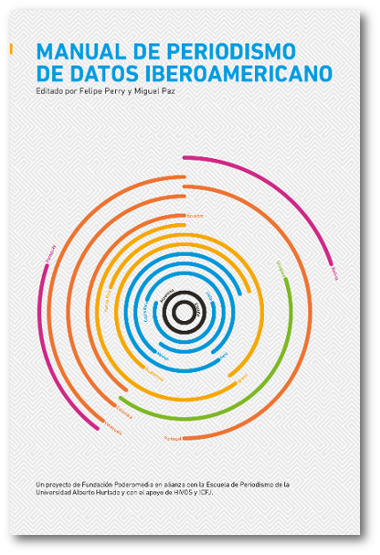 Cómo Investigar Temas Ambientales (Investigating Environmental Issues): A guide to investigating environmental issues in South America.
Cómo Investigar Temas Ambientales (Investigating Environmental Issues): A guide to investigating environmental issues in South America.
Guía Práctica sobre Periodismo de Datos (Practical Guide to Data Journalism) by Sandra Crucianelli, a Knight International Journalism Fellow. The guide provides tips on data visualization and explores case studies of reporters engaging in data journalism. It is published by the International Center for Journalists.
Manual de Periodismo de Datos Iberoamericano (Latin American Handbook of Data Journalism) provides tips and tutorials on data mining, deep web searches, data visualization, and more. The guide for Spanish-speaking reporters is published by the Poderomedia Foundation in partnership with the School of Journalism at the University Alberto Hurtado.
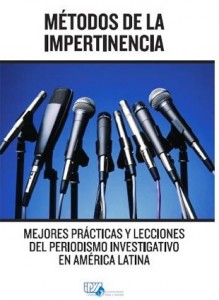 Métodos de la Impertinencia (Methods of Impertinence): The Venezuelan chapter of the Press and Society Institute (IPYS) released a collection of best practices and lessons for investigative journalism in Latin America. The book combines testimonies from 10 prominent journalists from the region.
Métodos de la Impertinencia (Methods of Impertinence): The Venezuelan chapter of the Press and Society Institute (IPYS) released a collection of best practices and lessons for investigative journalism in Latin America. The book combines testimonies from 10 prominent journalists from the region.
Periodismo de Investigacion (Investigative Journalism) by Gerardo Reyes. A comprehensive primer into investigative reporting in Latin America that includes sections on strategies and methodology.
Periodista de Investigacion Latinoamericano en la Era Digital (The Latin American Journalist: Research in the Digital Age) is produced by the Initiative for Journalism Research in the Americas and ICFJ in partnership with Connectas, and co-written by Nathalia Salamanca, Jorge Luis Sierra, and Carlos Eduardo Huertas.

